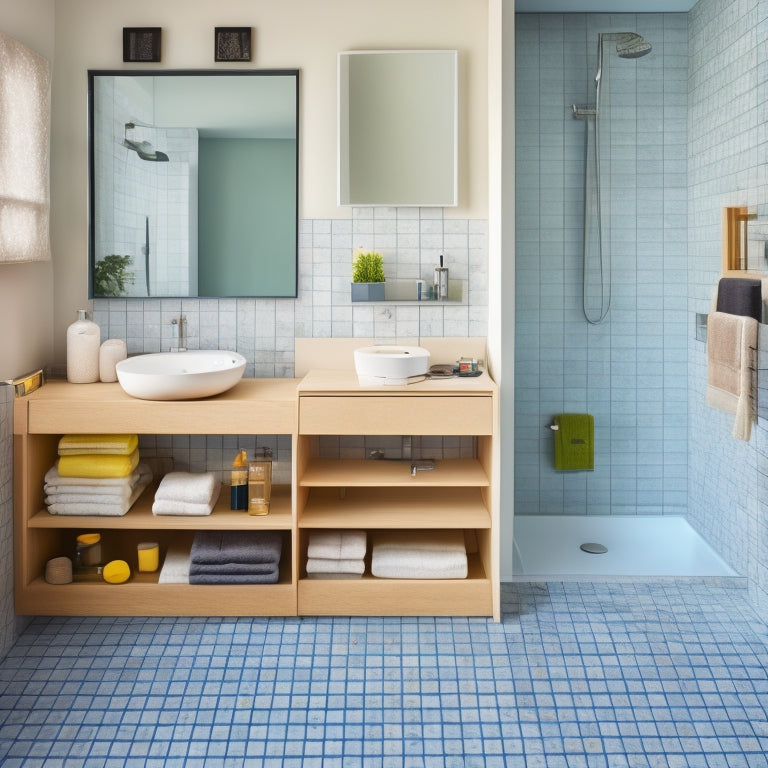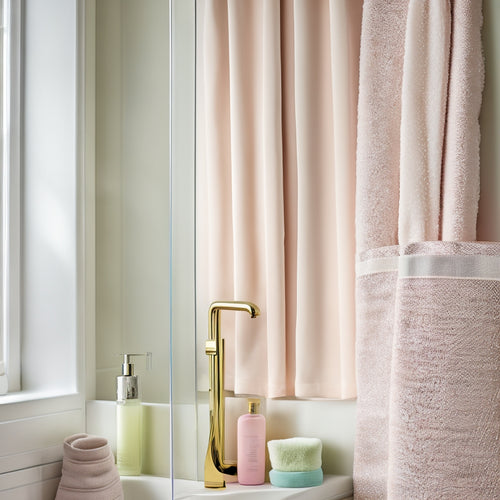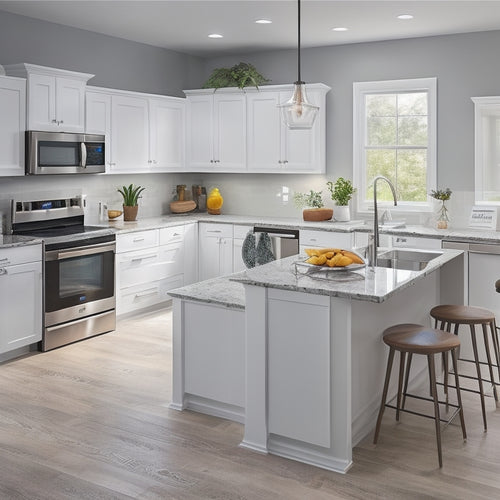
Bathroom Drawers Unit Measurement and Planning
Share
As you plan your bathroom drawers unit, accurate measurements are key to achieving a perfect fit. Focus on internal dimensions to accommodate your storage needs, considering ergonomic design preferences and material choices. Measure the width, height, and depth of your space, noting any obstructions like plumbing fixtures. Assess the items you'll be storing, from toiletries to towels, and balance deep and shallow drawer options. With typical depths ranging from 14 to 24 inches and widths from 12 to 36 inches, you'll want to choose the right size for your needs. Now, let's investigate the subtleties of bathroom drawer planning to reveal a design that's both beautiful and functional.
Key Takeaways
- Measure internal drawer dimensions to ensure a perfect fit and consider ergonomic design preferences for optimal storage.
- Account for plumbing fixtures, electrical outlets, and corners when measuring the bathroom space to plan for optimal drawer placement.
- Choose the right drawer size based on items to be stored, material, and aesthetic preferences, and prioritize frequently used items in easily accessible drawers.
- Ensure clearance between the countertop and drawer for comfortable access, and consider the ideal drawer height to avoid obstructing the view above the sink.
- Plan for corner drawers by measuring corner angles, determining storage items, and visualizing design integration with bathroom aesthetics.
Understanding Bathroom Drawer Dimensions
Measuring your bathroom drawers accurately is essential to guarantee a perfect fit for your new bathroom drawers unit. You wouldn't want to end up with a unit that's too big or too small for your space, right? So, take out that measuring tape and let's get started!
When measuring your drawers, reflect on the internal dimensions – the space where you'll store your bathroom essentials. Think about the ergonomic design you need. Do you prefer shallow drawers for easy access or deeper ones for more storage?
You'll also want to evaluate the type of drawer materials you prefer, from sleek glass to sturdy wood.
Measure the width, height, and depth of each drawer, taking note of any obstructions like plumbing or electrical outlets. Don't forget to record the measurements of the drawer slides or glides, as these can affect the overall fit.
With precise measurements, you'll be able to find the perfect bathroom drawers unit that meets your needs and complements your bathroom's style.
Measuring Your Bathroom Space
Now that you've got the internal dimensions of your drawers nailed down, it's time to shift your attention to the space where they'll be installed. Measure the length, width, and any obstacles in your bathroom to get a clear visualization of your space utilization.
Don't forget to account for plumbing, electrical outlets, and any awkward corners that might affect your bathroom layout.
Take note of the distance between the floor and any countertops, as well as the height of your sink and toilet. These measurements will help you determine the ideal placement of your drawers and guarantee they fit snugly beneath your countertops.
Consider the "work zones" in your bathroom, like the area around the sink and toilet, and how your drawers can be positioned to optimize functionality.
As you measure, imagine how you'll move around the space with your drawers installed. Will you have enough clearance to open the drawers comfortably? Are there any areas where you can squeeze in extra storage?
Choosing the Right Drawer Size
With your bathroom space measurements in hand, it's time to translate them into the perfect drawer size. You've got the numbers, now it's time to get specific. Reflect on the type of items you'll be storing in your drawers – toiletries, towels, or maybe even a hair dryer or two. This will help you determine the ideal depth and width of your drawers.
Don't forget to think about the drawer material, too. Will it be sleek and modern, or warm and traditional? Your aesthetic preferences will play a big role in choosing the right size and style.
When it comes to height, you'll want to reflect on the space between the countertop and the floor. You don't want your drawers to be so tall they're awkward to reach, but you also don't want them to be so short they're impractical.
Think about the items you'll be storing and how often you'll need to access them. A good rule of thumb is to keep frequently used items in easy-to-reach drawers, and less frequently used items in harder-to-reach ones.
Planning for Corner Drawers
Two corners in your bathroom are crying out for optimization. Don't let them remain dead space! Planning for corner drawers is all about making the most of these often-wasted areas. With clever corner drawer design, you can squeeze in extra storage without sacrificing style.
When measuring for corner storage solutions, consider the angle of the corner and the available space. You'll want to choose a corner drawer that fits snugly into the space, without obstructing the surrounding area.
Think about what you'll be storing in these drawers - toiletries, towels, or maybe even a hidden trash can? This will help you determine the ideal size and configuration.
Visualize the finished product: a sleek, modern corner drawer that seamlessly blends into your bathroom's design. To achieve this, consider factors like the drawer's shape, material, and hardware.
Will you opt for a soft-close mechanism or a stylish pull-out design? By carefully planning for corner drawers, you'll create a bathroom that's both beautiful and functional.
Accounting for Plumbing Fixtures
Measure carefully around plumbing fixtures like sinks, toilets, and bidets to ascertain your corner drawers fit perfectly. Don't assume you can just squeeze them in – you might end up with a drawer that opens only halfway because it's blocked by the sink pipes.
Take precise measurements to verify you have enough clearance for plumbing access. You'll need to account for fixture placement, too, as it can affect the overall layout of your bathroom.
For example, if your sink is mounted under a window, you'll need to take into account the space required for the faucet and pipes. Similarly, toilets and bidets have their own unique space requirements.
Make a sketch or drawing of your bathroom layout, including the plumbing fixtures, to visualize the space constraints. This will help you determine the ideal size and placement of your corner drawers.
Considering Drawer Configuration Options
Now that you've accounted for plumbing fixtures, you're ready to tackle the fun part: configuring your corner drawers to maximize storage and style. This is where your dream bathroom starts taking shape!
When considering drawer configuration options, think about your daily routine. Do you need a dedicated drawer for skincare products or a separate one for hair accessories?
Drawer organization is key to a stress-free morning routine. You want to guarantee ergonomic access to your essentials, so you're not straining your back or shoulders while getting ready.
Opt for a configuration that includes a mix of shallow and deep drawers. Shallow ones are perfect for storing small items like jewelry or cotton balls, while deeper drawers can hold bulkier items like towels or hair dryers.
Consider a drawer divider system to keep items from getting jumbled and make the most of your space. With a little creativity, your bathroom drawers can become a haven of organization and efficiency.
Bathroom Drawer Depth Guidelines
When planning your bathroom drawers, you'll want to take into account the ideal drawer depth to guarantee a functional and comfortable space.
Typical bathroom drawer depths range from 14 to 24 inches, with standard sizes including 15, 18, and 21 inches.
Ideal Drawer Depths
In designing your bathroom drawers, you're likely to encounter an essential question: how deep should they be? It's vital to get this measurement right, as it directly impacts the functionality and aesthetics of your bathroom.
When deciding on the ideal drawer depth, consider the following factors:
-
Drawer material: Thicker materials like solid wood or MDF require more depth to guarantee structural integrity, while thinner materials like laminate can get away with shallower depths.
-
Drawer organization: If you plan to store larger items like towels or toiletries, you'll need deeper drawers to accommodate them.
-
Countertop clearance: Verify there's enough clearance between the countertop and the drawer to prevent clutter and allow for easy access.
- Personal preference: Ultimately, the ideal drawer depth depends on your personal style and needs – do you prefer a sleek, minimalist look or ample storage space?
Standard Drawer Sizes
Standard drawer sizes serve as a significant reference point for designing bathroom drawers that are both functional and aesthetically pleasing.
As you plan your bathroom drawers, it's crucial to take into account the standard sizes to guarantee a seamless installation and peak functionality. Typically, bathroom drawer sizes range from 12 to 36 inches in width, with increments of 3 to 6 inches. Depth-wise, you'll find standard sizes between 15 and 24 inches, with most common depths being 18, 20, and 22 inches.
When selecting a drawer size, reflect on the type of items you'll store and the ergonomic design. For instance, a 12-inch wide drawer is perfect for storing small toiletries, while a 24-inch wide drawer can accommodate larger items like towels and linens.
Additionally, think about the drawer material; soft-close drawers require more space than traditional ones. By adhering to standard drawer sizes, you'll guarantee a harmonious blend of form and function in your bathroom.
Selecting the Ideal Drawer Height
When selecting the ideal drawer height for your bathroom, you'll need to take into account the options available, typically ranging from 24 to 36 inches.
You'll also want to think about the space above your sink, ensuring the drawer doesn't obstruct your view or create a cramped feel.
Additionally, don't forget to factor in countertop clearance needs, as you'll want to leave enough room to comfortably stand and move around the area.
Drawer Height Options
How do you envision the perfect bathroom drawers unit - one that seamlessly blends form and function? When it comes to drawer height options, you've got a few factors to think about.
Drawer height factors can make or break the functionality of your bathroom drawers unit. You want to guarantee that the drawers are accessible, yet not so low that they're awkward to use. Adjustable drawer heights can be a revolutionary aspect, allowing you to customize the space to fit your needs.
Here are a few options to think about:
-
Standard height: Ideal for average-sized users, standard height drawers typically range from 5-7 inches tall.
-
Tall height: Perfect for storing larger items or for users who prefer a more ergonomic experience, tall height drawers can range from 8-10 inches tall.
-
Compact height: Great for smaller bathrooms or for storing smaller items, compact height drawers typically range from 3-5 inches tall.
- Custom height: If you've got specific storage needs or preferences, think about opting for custom drawer heights that cater to your unique requirements.
Space Above Sink
Frequently, the space above your sink becomes a prime real estate for bathroom storage, and selecting the ideal drawer height is crucial to maximizing this area. When choosing the perfect drawer height, consider the sink clearance to avoid a cramped, cluttered look.
You'll want to guarantee there's enough space between the sink and the drawer to accommodate your needs comfortably. A general rule of thumb is to leave about 2-3 inches of clearance between the sink and the top of the drawer. This will provide a visually appealing balance and create a sense of openness.
Design aesthetics also play a significant role in determining the ideal drawer height. Consider the style and shape of your sink, as well as the overall bathroom design.
For instance, if you have a pedestal sink, you may want to opt for a taller drawer to create a sense of continuity. Conversely, if you have a vessel sink, a shorter drawer might be more suitable.
Countertop Clearance Needs
Beyond the sink clearance, the countertop's surface area plays a critical role in determining the ideal drawer height. As you plan your bathroom drawers unit, take into account the type of countertop materials you'll be using. Will it be sleek granite, refined marble, or durable quartz? The material's thickness will impact the overall height of your drawers.
To guarantee a harmonious design, you'll want to balance the countertop's surface area with the drawer aesthetics. Here are some key factors to keep in mind:
-
Countertop thickness: Measure the material's thickness to determine how much clearance you'll need for the drawers.
-
Drawer handles and knobs: Factor in the height of the handles or knobs to make sure they don't interfere with the countertop's surface.
-
Countertop edges: Think about the style of the countertop edges – will they be rounded, beveled, or square? This will impact the overall look and feel of your drawers.
- Clearance for plumbing: Don't forget to leave enough clearance for plumbing fixtures, such as faucets and drains, to guarantee a smooth installation.
Maximizing Storage With Dividers
With the bathroom drawers unit in place, you're ready to tackle the challenge of maximizing storage within this compact space.
It's time to get creative with drawer organization and storage solutions. Dividers are your new best friends, and the right materials can make all the difference. Adjustable dividers are a great option, allowing you to customize your storage space as needed.
But don't forget about aesthetic appeal – choose dividers that complement your bathroom's style.
Compartmentalized storage is key to maximizing efficiency. Custom dividers can help you create separate spaces for toiletries, skincare products, and other essentials, keeping them organized and easy to access.
Decluttering strategies are essential to maintaining this organized space, so make sure to purge any unnecessary items before implementing your new storage system.
Frequently Asked Questions
Can I Mix and Match Different Drawer Sizes in One Unit?
You want to know if you can mix and match drawer sizes in one unit? Absolutely! By doing so, you'll create a visually appealing aesthetic balance, and with clever drawer organization, you'll maximize storage while adding a hint of playful whimsy to your space.
How Do I Clean and Maintain Bathroom Drawers Effectively?
You expertly tackle bathroom drawer chaos by implementing a solid drawer organization system, then whip out your trusty cleaning supplies, like a gentle yet fierce warrior, to conquer dust bunnies and grime, leaving your drawers sparkling like new!
Are Soft-Close Drawers Worth the Extra Cost Investment?
As you're sipping coffee, you coincidentally slam a drawer, spilling it everywhere - proof you need soft-close drawers! Worth the extra cost? Absolutely, considering the benefits: reduced noise, increased durability, and a clutter-free morning, all while saving you from caffeine-fueled chaos; it's a small price to pay for sanity.
Can Bathroom Drawers Be Installed in a DIY Project?
You're wondering if you can tackle drawer installation on your own - and the answer is yes! With the right DIY tools and a sprinkle of patience, you'll be sliding those drawers open and shut like a pro in no time.
What Is the Ideal Material for Bathroom Drawer Construction?
When building your dream bathroom drawers, you'll want materials that scream "drama and durability!" Look for moisture-resistant materials like waterproof MDF, PVC, or solid wood with a water-repellent finish - they'll keep your drawers looking fabulous and functional, even in humid conditions!
Conclusion
As you finalize your bathroom drawers unit, remember that precision is key. Measure twice, plan carefully, and consider every detail. Balance functionality with aesthetics, and don't sacrifice storage for style. With the right dimensions, configuration, and dividers, your bathroom drawers will become a harmonious blend of form and function, where every item has its perfect place, and every morning routine becomes a seamless experience.
Related Posts
-

Innovative Tool Empowers Writing With Digital Mapping
Digital mind mapping tools have revolutionized the writing process by providing a powerful platform for conceptual or...
-

Craft Your Own Multi-Pocket Bath Caddy
We're about to craft a multi-pocket bath caddy that's both functional and stylish! To get started, we'll prepare our ...
-

Kitchen Remodeling Made Easy: Free Planning Tools
I'm excited to transform my kitchen into a stunning space, but I know that without a clear plan, my dream can quickly...


